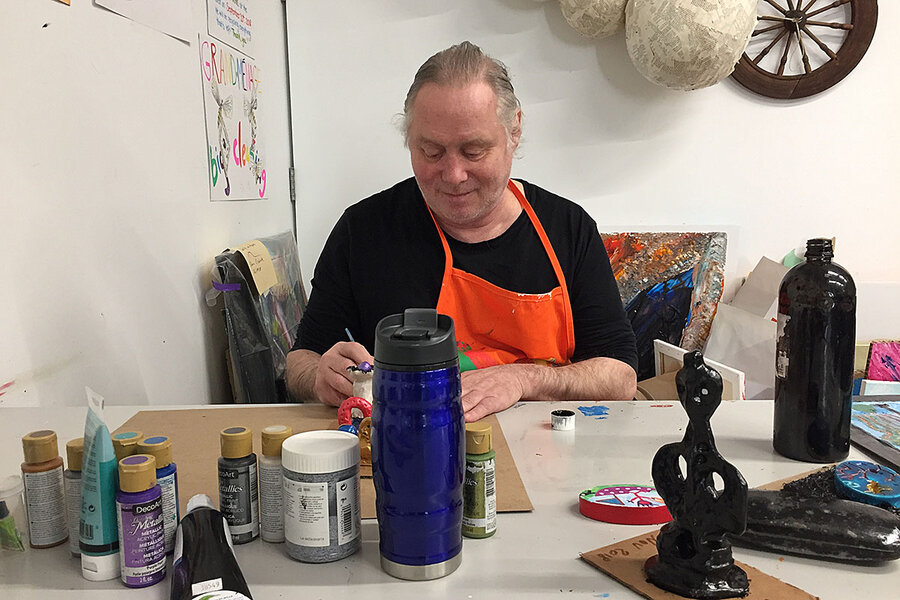Prescription art: Take in two museums and call me in the morning
Loading...
| Montreal
The five pavilions that comprise the Montreal Museum of Fine Arts, one of Canada’s most prominent institutions, draw their share of art lovers, of tourists, and of ragtag school groups.
But they aren’t the only visitors inspecting the fall foliage depicted by Tom Thomson and Canada’s “Group of Seven” artists or experiencing works of French painters from Jean-Baptiste-Camille Corot to Henri Matisse.
During any given week, there are deaf teens and young adults viewing the works as part of their education in how to overcome obstacles to communication through art. Women with eating disorders listen as guides share points about works that might encourage expression of their emotions around body image. Visitors diagnosed with Alzheimer’s explore themes such as nature and family to stimulate conversation that can sometimes help to evoke memories.
Why We Wrote This
Can sending patients to view art be a therapeutic tool? Physicians in Montreal are working with one of Canada's most prestigious museums to find out, testing new ways of thinking about treatment and healing.
Those efforts were so successful that the MMFA has expanded them in an unusual way: by partnering with the Médecins francophones du Canada, a membership association for French-speaking doctors, who can use their prescription pads to order visits to the museum for patients in lieu of perhaps medicine or a follow-up doctor’s appointment.
At a time when the health community is grasping for solutions to over-prescribing and over-testing, “social prescribing” – in which practitioners look at community activities and nonclinical services as a more holistic approach to wellness – is gaining renewed attention. In the case of art museums in particular, supporters say doctor-ordered visits can carve out crucial space for stillness and observation and provide an antidote to social exclusion.
“It’s not just doctors prescribing pills but patients taking action and putting in their own hands their own healing,” says Yan Yee Poon, an art therapist working at the MMFA on a recent day. “Art speaks to everyone. We can all find something in it we need.”
The year-long experiment, which allows each doctor to issue up to 50 prescriptions that give patients free admission to the MMFA, comes as social prescribing, which took off in Britain, is growing. Doctors increasingly see the role of choirs, sports teams, and arts programs as a key to social inclusion and health outcomes for everyone from patients diagnosed with Alzheimer’s to those with anxiety or depression. British studies have also measured a decline in use of the national health system when social prescribing is utilized.
This month the Royal Ontario Museum announced that health-care and social service providers can prescribe visits to the Toronto institution to promote health and well-being. It begins in January.
‘A solution they didn’t know was there’
The MMFA has a long commitment to fostering wellness through arts, of which the project, the first of its kind in Canada, is just the latest expression. Marilyn Lajeunesse, educational programs officer, says the health component grew out of the “Sharing the Museum” initiative to make the museum more inclusive. In its 19th year, the program revealed how much populations in need benefited from being part of the museum community. “We started realizing that visits to the museum were quite beneficial to not only people with psychological issues but people who are fragile in the first place,” she says.
Today the MMFA estimates some 300,000 people partake in their educational, cultural, community-based, and art therapy programs. They employ a full-time art therapist, which they say is the first for any museum. To measure it all, the museum is currently participating in 10 clinical studies supervised by its Art and Health Advisory Committee, chaired by Rémi Quirion, chief scientist of Quebec. They have housed an Art Hive, a twice-weekly session allowing the community to drop in to make art, since 2017.
Robert Kertesz, a retired Montrealer, is at the Art Hive on recent Sunday afternoon, applying India ink to the base of a clay structure of fanciful characters. He says it was inspired by a Tom Petty video, “Don’t Come Around Here No More,” based on “Alice in Wonderland.” Mr. Kertesz, who learned about the Art Hive through a seniors program he joined, says even though he doesn’t consider himself a nervous person, it’s still calming to be here – to get out of the house and spend time with people, listening to music, and creating. For those who are depressed or can’t sleep well, he adds, art can be an enormous aid.
“They might be prompted to find a solution they didn’t know was there,” he says.
Ms. Poon, who is working at the Art Hive this day, says that creating art allows people to explore their feelings at a certain distance that often feels safer. But prescriptions to the museum, she says, are an empowerment tool too.
Nicole Parent, the director general of Médecins francophones du Canada, says the healing process of art is not prescriptive. “It might be a moment to step away from stress and anxiety.” Contemplating a piece of art might generate positive feelings as a patient reflects on his or her life, Dr. Parent, an epidemiologist, says, “or it could be a dark piece in which they recognize themselves.” In either case, she says, it can provide an awakening.
The MMFA says that art’s role in healing might be viewed the way mindfulness or meditation is today, or exercise and diet in the past. Upon the unveiling of the plan, Nathalie Bondil, the MMFA director general, said, “In the 21st century, culture will be what physical activity was for health in the 20th century.”
Or as Kertesz puts it, “It feels good to be creative. It’s been therapeutic. I’m not afraid to use the word. ... It’s just a very positive place.”






